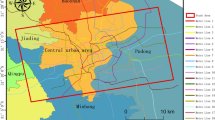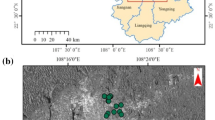Abstract
Long-term over-exploitation of underground water, static and dynamic load is increasing year by year, which influenced the occurrence and development of regional land subsidence in Beijing, China. We used Envisat advanced synthetic aperture radar data acquired from 2003 to 2009 and PSI (persistent scatterers for SAR interferometry) and small baseline technology to estimate regional land subsidence information in Beijing, China. In different situation of space utilization, we chose five typical settlement areas according to classified information of land-use, multi-spectral remote sensing images and geological data. We analyzed the time-series evolution characteristics of uneven subsidence by GIS spatial analysis. The comparative analysis results suggest that for five typical settlement areas, the complex situations of space utilization affect the trend of uneven subsidence, the simpler space utilization situation (relatively fewer transport lines, construction), the smaller settlement differences and the smaller trend of the uneven subsidence.















Similar content being viewed by others
References
Bell JW, Amelung F, Ferretti A, Bianchi M, Novali F (2008) Permanent scatterer InSAR reveals seasonal and long-term aquifer-system response to groundwater pumping and artificial recharge. Water Resour Res. doi:10.1029/2007WR006152
Berardino P, Fornaro G, Lanari R, Sansosti E (2002) A new algorithm for surface deformation monitoring based on small baseline differential SAR interferograms. IEEE Trans Geosci Remote Sens 40:2375–2383. doi:10.1109/TGRS.2002.803792
Bürgmann R, Hilley G, Ferretti A, Novali F (2006) Resolving vertical tectonics in the san francisco bay area from permanent scatterer InSAR and GPS analysis. Geology 34(3):221–224
Casu F, Manzo M, Lanari R (2006) A quantitative assessment of the SBAS algorithm performance for surface deformation retrieval from DInSAR data. Remote Sens Environ 102(3–4):195–210. doi:10.1016/j.rse.2006.01.023
Colesanti C, Ferretti A, Novali F, Prati C, Rocca F (2003) SAR monitoring of progressive and seasonal ground deformation using the permanent scatterers technique. IEEE Trans Geosci Remote Sens 41:1685–1701. doi:10.1109/TGRS.2003.813278
Ferretti A, Prati C, Rocca F (2000) Nonlinear subsidence rate estimation using permanent scatterers in differential SAR interferometry. IEEE Trans Geosci Remote Sens 38:2202–2212. doi:10.1109/36.868878
Gourmelen N, Amelung F, Casu F, Manzo M, Lanari R (2007) Mining-related ground deformation in Crescent Valley, Nevada: implications for sparse GPS networks. Geophys Res Lett. doi:10.1029/2007GL029427
Gourmelen N, Amelung F, Lanari R (2010) Interferometric synthetic aperture radar–GPS integration: interseismic strain accumulation across the Hunter Mountain fault in the eastern California shear zone. J Geophys Res Solid Earth 1978–2012:115. doi:10.1029/2009JB007064
Hoffmann J, Zebker HA, Galloway DL, Amelung F (2001) Seasonal subsidence and rebound in Las Vegas Valley, Nevada, observed by synthetic aperture radar interferometry. Water Resour Res 37:1551–1566. doi:10.1029/2000WR900404
Hooper AJ (2006) Persistent scatter radar interferometry for crustal deformation studies and modeling of volcanic deformation. Ph.D. thesis, Stanford University
Hooper A (2008) A multi-temporal InSAR method incorporating both persistent scatterer and small baseline approaches. Geophys Res Lett 35:L16302. doi:10.1029/2008GL034654
Jia SM, Tian F, Liu MK, Yang Y (2012) The risk assessment method and standard on the construction land subsidence in Beijing area urban. Geology 7:7–11. doi:10.3969/j.issn.1007-1903.2012.04.002
Liu JG, Mason P, Hilton F, Lee H (2004) Detection of rapid erosion in SE Spain. Photogramm Eng Remote Sens 70:1179–1185. doi:10.14358/PERS.70.10.1179
Meisina C, Zucca F, Fossati D, Ceriani M, Allievi J (2006) PS InSAR integrated with geotechnical GIS: some examples from southern Lombardia. In: Geodetic deformation monitoring: from geophysical to engineering roles, Vol 131. Springer, pp 65–72
Strozzi T, Wegmuller U, Tosi L, Bitelli G, Spreckels V (2001) Land subsidence monitoring with differential SAR interferometry. Photogramm Eng Remote Sens 67:1261–1270
Usai S (2003) A least squares database approach for SAR interferometric data. IEEE Trans Geosci Remote Sens 41:753–760. doi:10.1109/TGRS.2003.810675
Xu Caijun, Jiang Guoyan, Wang Hao, Wen Yangmao (2011) Analyzing InSAR results using GIS and its application on the coseismic interpretation of Mw7.9 Wenchuan earthquake. Geo Inf Sci Wuhan Univ 36(4):379–383
Zhou G, Esaki T, Mori J (2003) GIS-based spatial and temporal prediction system development for regional land subsidence hazard mitigation. Environ Geol 44:665–678. doi:10.1007/s00254-003-0806-1
Acknowledgments
This work was funded by the National Natural Science Foundation of China (Nos. 41130744/D0107, 41171335/D010702, 41401492/D010702), and the National Basic Research Program of China (973 Program) (2012CB723403).
Author information
Authors and Affiliations
Corresponding author
Rights and permissions
About this article
Cite this article
Chen, B., Gong, H., Li, X. et al. Spatial–temporal evolution patterns of land subsidence with different situation of space utilization. Nat Hazards 77, 1765–1783 (2015). https://doi.org/10.1007/s11069-015-1674-1
Received:
Accepted:
Published:
Issue Date:
DOI: https://doi.org/10.1007/s11069-015-1674-1




